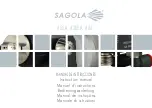
12
308718
Spray Techniques
Tip Selection Chart
Application
Tip Orifice
2
Air Volume
1
Fog
1/8 in.
high
Simulated
acoustic
3/16 in.
(fine, for small
confined areas)
1/4 in.
(fine to medium)
5/16 in.
(coarse)
medium to
high
Orange peel
1/8 to 3/16 in.
medium to
high
Splatter coat
1/4 to 5/16 in.
low to
medium
Knockdown
5/16 in.
low
1
Control air volume with the gun air flow valve (424).
2
For more material volume, try a larger-orifice tip.
Adjusting the System
Sufficient fluid output (volume and pressure) and good
atomization require testing to balance the compressor
air to the gun and pump and proper tip selection. Keep
in mind these important points when adjusting the gun:
Read all of pages 12 and 13 before spraying.
Start the sprayer with the gun air flow valve (424) at
its maximum setting (fully +). If needed, slowly
decrease the gun air flow until you get a good spray
pattern. Use the minimum amount of air at the
spray gun to achieve the proper spray pattern and
to minimize bounce back.
– Test the spray pattern on cardboard. Hold the
gun 18 to 30 in. (457 to 762 mm) from the
surface. Use this spraying distance for most
applications.
– Overlap each stroke 50% in a circular motion.
Select the proper tip for your application. See the
Tip Selection Chart at left. Consider the size of
aggregate in the material and the coarseness of the
spray pattern. Remember, the larger the tip, the
heavier the pattern.
All spraying adjustments are made at the gun.
Material pressure and flow rate adjustments are
made at the regulator.
The compressor provides air to the gun and the
pump; thus, the more air you supply to the gun, the
less that is available for the pump.
– Turning the air flow valve (424) toward (+)
increases air flow through the gun, which
decreases texture material flow through the
pump.
– Turning the air flow valve (424) toward (–)
decreases air flow through the gun, which
increases texture material flow through the
pump.













































